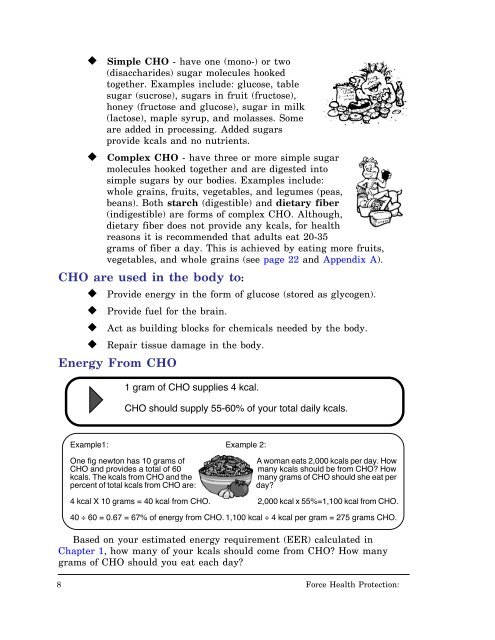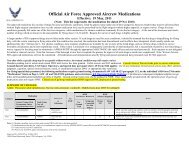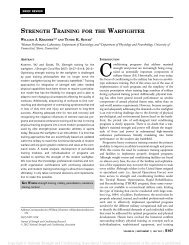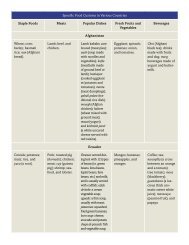Force Health Protection: Nutrition and Exercise Resource Manual
Force Health Protection: Nutrition and Exercise Resource Manual
Force Health Protection: Nutrition and Exercise Resource Manual
Create successful ePaper yourself
Turn your PDF publications into a flip-book with our unique Google optimized e-Paper software.
◆ Simple CHO - have one (mono-) or two<br />
(disaccharides) sugar molecules hooked<br />
together. Examples include: glucose, table<br />
sugar (sucrose), sugars in fruit (fructose),<br />
honey (fructose <strong>and</strong> glucose), sugar in milk<br />
(lactose), maple syrup, <strong>and</strong> molasses. Some<br />
are added in processing. Added sugars<br />
provide kcals <strong>and</strong> no nutrients.<br />
◆ Complex CHO - have three or more simple sugar<br />
molecules hooked together <strong>and</strong> are digested into<br />
simple sugars by our bodies. Examples include:<br />
whole grains, fruits, vegetables, <strong>and</strong> legumes (peas,<br />
beans). Both starch (digestible) <strong>and</strong> dietary fiber<br />
(indigestible) are forms of complex CHO. Although,<br />
dietary fiber does not provide any kcals, for health<br />
reasons it is recommended that adults eat 20-35<br />
grams of fiber a day. This is achieved by eating more fruits,<br />
vegetables, <strong>and</strong> whole grains (see page 22 <strong>and</strong> Appendix A).<br />
CHO are used in the body to:<br />
◆ Provide energy in the form of glucose (stored as glycogen).<br />
◆ Provide fuel for the brain.<br />
◆ Act as building blocks for chemicals needed by the body.<br />
◆ Repair tissue damage in the body.<br />
Energy From CHO<br />
1 gram of CHO supplies 4 kcal.<br />
CHO should supply 55-60% of your total daily kcals.<br />
Example1:<br />
One fig newton has 10 grams of<br />
CHO <strong>and</strong> provides a total of 60<br />
kcals. The kcals from CHO <strong>and</strong> the<br />
percent of total kcals from CHO are:<br />
4 kcal X 10 grams = 40 kcal from CHO.<br />
Example 2:<br />
A woman eats 2,000 kcals per day. How<br />
many kcals should be from CHO? How<br />
many grams of CHO should she eat per<br />
day?<br />
2,000 kcal x 55%=1,100 kcal from CHO.<br />
40 ÷ 60 = 0.67 = 67% of energy from CHO. 1,100 kcal ÷ 4 kcal per gram = 275 grams CHO.<br />
Based on your estimated energy requirement (EER) calculated in<br />
Chapter 1, how many of your kcals should come from CHO? How many<br />
grams of CHO should you eat each day?<br />
8 <strong>Force</strong> <strong>Health</strong> <strong>Protection</strong>:






![Body Composition and Military [PDF] - Human Performance ...](https://img.yumpu.com/43269347/1/190x245/body-composition-and-military-pdf-human-performance-.jpg?quality=85)
![Tips for Grocery Shopping [PDF]](https://img.yumpu.com/37447379/1/190x245/tips-for-grocery-shopping-pdf.jpg?quality=85)



![Synthetic Drugs [PDF] - Human Performance Resource Center](https://img.yumpu.com/37447322/1/190x245/synthetic-drugs-pdf-human-performance-resource-center.jpg?quality=85)


